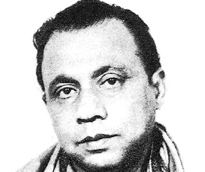Abul Hasnat Muhammad Qamaruzzaman facts for kids
Quick facts for kids
Abul Hasnat Muhammad Qamaruzzaman
|
|
|---|---|
|
আবুল হাসনাত মোহাম্মদ কামারুজ্জামান
|
|
 |
|
| Minister of Industries | |
| In office 25 January 1975 – 15 August 1975 |
|
| President | Sheikh Mujibur Rahman |
| Prime Minister | Muhammad Mansur Ali |
| Preceded by | Syed Nazrul Islam |
| Succeeded by | Sultan Mahmud |
| 5th President of Bangladesh Awami League | |
| In office 18 January 1974 – 24 February 1975 |
|
| General Secretary | Zillur Rahman |
| Preceded by | Sheikh Mujibur Rahman |
| Succeeded by | Syeda Zohra Tajuddin |
| Member of Jatiya Sangsad | |
| In office 7 April 1973 – 18 January 1974 |
|
| Preceded by | Constituency established |
| Constituency | Rajshahi |
| 1st Minister of Home Affairs (in exile) | |
| In office 10 April 1971 – 12 January 1972 |
|
| President |
|
| Prime Minister | Tajuddin Ahmed |
| Preceded by | Office established |
| Succeeded by | Abdul Mannan |
| Personal details | |
| Born | 26 June 1926 Natore, Bengal, British India (now Rajshahi, Bangladesh) |
| Died | 3 November 1975 (aged 49) Dacca, Bangladesh |
| Political party | Awami League |
| Children | A. H. M. Khairuzzaman Liton |
| Occupation | Politician, minister |
Abul Hasnat Muhammad Qamaruzzaman (born June 26, 1926 – died November 3, 1975) was an important politician and government minister in Bangladesh. He was a leading member of the Awami League, a major political party.
Qamaruzzaman was part of the Mujibnagar Government, which was Bangladesh's first government during its fight for independence. Sadly, he died in prison on November 3, 1975, in Dhaka. This happened along with other important leaders like Syed Nazrul Islam, Muhammad Mansur Ali, and Tajuddin Ahmed.
Early Life and Education
Abul Hasnat Muhammad Qamaruzzaman was born on June 26, 1926. His birthplace was the city of Bagatipara Upazila, in Natore, which was then part of Bengal. Today, this area is in Bangladesh.
He was a very smart student. In 1946, he earned a degree in economics from the University of Calcutta. Later, in 1956, he studied law and got a law degree from Rajshahi University. After finishing his studies, he started working as a lawyer in Rajshahi District.
Even as a student, Qamaruzzaman was interested in politics. He joined the All-India Muslim League, a political group. He worked to support the Pakistan movement, which aimed to create an independent country called Pakistan.
Political Journey
Qamaruzzaman officially joined the Awami League political party in 1956. His political career grew steadily from there. He was elected to the National Assembly of Pakistan several times. These elections happened in 1962, 1965, and again in 1970.
By the late 1960s, he became a very important leader within his party. During the Bangladesh Liberation War, which was Bangladesh's fight for freedom, Qamaruzzaman played a key role. He served as the minister of relief and rehabilitation. This meant he helped people who were affected by the war. He was part of the first temporary government of Bangladesh, formed in Mujibnagar.
After Bangladesh became an independent country, he continued his political work. In 1973, he was elected to the national parliament from Rajshahi. He later resigned from this role in 1974 to become the president of the Awami League. In 1975, he was appointed as the minister of industries. He also became a member of the executive committee of BAKSAL, another political group.
His Legacy
After the sad passing of Sheikh Mujibur Rahman in August 1975, Qamaruzzaman was arrested. He was put in Dhaka Central Jail along with other senior Awami League politicians. These included Tajuddin Ahmed, Syed Nazrul Islam, and Mansur Ali.
Tragically, these four leaders died in prison on November 3, 1975. Abul Hasnat Muhammad Qamaruzzaman is remembered as a brave leader who worked for the independence and development of Bangladesh.
His son, A. H. M. Khairuzzaman Liton, has also become a politician. He is a member of the Awami League and serves as the mayor of Rajshahi City.

